Old Salt
The Record-Breaking Life Of Fred Larsen
By Dick Martin
Photography: Dick Martin, Fred Larsen Collection, Greg Sharp Collection
“Why do you want to do a story on me?” That was Fred Larsen’s reaction when we approached him. Guys like Larsen are the reason Hot Rod magazine was created. He is the definitive, no-nonsense hot rodder. A member of the 300-mph chapter of the Bonneville 200-mph Club, Fred is not one to mince words. His comments can be razor-sharp. Even so, when it comes to racing, he lets his countless national and international speed records do the talking for him. A 1963 L.A. Times article summed up his success: “The most consistent winner at the annual Bonneville speed trials for the past five years has been a retired Navy chief petty officer from La Mirada, Fred Larsen.” Setting new records every year from 1959 through 1963 at Bonneville was just the beginning. Far greater achievements were yet to come on the salt for the Fred and partner Don Cummins.
Fred grew up in Culver City, California, on the west side of Los Angeles, and he was a spectator at the first dry lakes meet in Muroc in 1936. He was immediately smitten with dry lakes racing, but not necessarily with the dry lakes. “It was the same then as it is today,” Fred says. “Dirty!” Larsen built his first dry lakes racer, a ’25 Model T roadster with a Winfield carb and Ricardo head, in 1938. Later, he ran a Chevy roadster with a ’28 Chevy four and an Olds head, replacing the Chevy with a much lighter ’27 T body. It ran 85 mph in 1940. His last car before the war was a ’29 Model A with a four-banger and a Winfield head and carburetor, which ran 112 mph—quite respectable in 1941.
’40s-Style Roddin’
Fred drove what was probably one of the first cross-country cruisers. While in the Navy in 1948, he bought a ’29 Ford roadster and drove it from California to Connecticut and then all over the eastern seaboard. Fred says, “It had a flat-knocker [flathead engine], a full bellypan…the whole nine yards. I put a ton of miles on that puppy back there, then drove it back to California and turned it into a lakes and drag-race car.”
After returning to Culver City, Larsen joined the Screwdrivers car club. As one of the clubs in the Russetta Timing Association, it was responsible for setting up the racecourse on the lakebed. Larsen and other club members would arrive at El Mirage at 7:30 a.m. to mark the course. Since they would be running the track, too, they chose carefully. Fred pushed his metallic-green ’29 roadster to 141.73 mph in the B Roadsters class in 1951. It didn’t take long before his counterparts and the motoring press noticed his success.
Like most of his fellow racers, Fred drove his car to the lakes, so switching to alcohol at the race was time-consuming and costly. In a Jan. ’52 article, Fred told Hop Up magazine that he liked the idea of a new class limited to gas, commenting that he spent $20 a week on alcohol while gas was only a couple of bucks.
Street To Strip
By the early ’50s, streetcars had disappeared from Southern California. In Culver City, a half-mile berm where the streetcar tracks had been removed provided a stretch of road ideal for street racing. “Usually after a Screwdrivers meeting, someone would have a go of it,” Fred says. “We’d stick a car down at one end to keep some celery farmer from pulling out.” When strips opened at Santa Ana, Colton, and later at Saugus, racing was drawn away from the streets.
Salt In The Wound
As Fred’s interest in drag racing evolved, so did his cars. He bought Ak Miller’s rear-engine roadster, Miller’s Missile, put a Chrysler in it, and ran it at the lakes as well as local strips. In 1957, he flipped the car at Bonneville. “I tore my face and head all to hell,” Fred recalls. “The mag broke off, hit me on the back of the head, and took my helmet off. I went sideways and over backward 180 feet when I hit the first time. The car was going backward upside-down, and I slid on my head on the salt. I had 180 stitches on my head and face.
After a major crash, most racers back off—not Fred. He built a front-engine Modified Roadster that set a record every year from 1959 to 1964. The ’27 T, built on ’32 rails and stuffed with a 445ci blown Chrysler, was a winner in the looks department and in racing, and it helped introduce Fred to the rest of the world through magazine coverage. Remnants of that car were discovered recently, and the historic record-holder is now in the process of restoration.
In 1962, Fred went to work as a machinist for Moon Equipment Company, the only organization he’s ever worked for. “Dean Moon was a very hard person to work for,” Fred says, “but it was 10 minutes from home, I had free run of a machine shop, and he needed me to go to Bonneville.”
Few realize that Shelby’s Cobra program began at Moon’s shop. Fred built the prototype. “Dean put me on lend-lease to Carroll Shelby, who leased part of the building from Moon,” he says. “In 1962, we picked up an AC Cobra chassis and body. Ford sent the first motor, a 221. Mel Chastain and I put in the motor, transmission, and driveline, and I built those outside headers. Carroll kept dragging header guys in to look at my configuration. They said, ‘You can’t beat it.’ When Shelby moved to Venice, California, he asked me to go with him. I said no.”
Building The Streamliner
Larsen’s friendship with Don Cummins (who passed away last year) began on-ship in the Navy in 1952. Both were from Southern California, and they became neighbors in civilian life and successful partners in racing.
After his crash at Bonneville, Fred teamed with Don to build his first from-the-ground-up race car using the classic slingshot, front-engine design. Engineer Lynn Yakel designed the body, applying the principles of aerodynamic airplane design. Don and Fred built the chassis and the motors. The genius of the chassis design was that it could have been run on the salt without the body. Everything was tucked inside, which made it ideal for testing and inspection. Two engines were built: one for the D class and one for the E class. The engine size could not be any larger than 183 ci to compete in D class and 120 ci for the E class. Fred chose the Chevy V-8 for both classes. A ’59 265 block with a 5/8-inch destroked crank was used to create the 183ci V-8.
Heads were from a 283-inch Chevy. With a 4-71 GMC blower, the estimated horsepower was 450. “The little 180-incher is the smallest Chevy V-8 I’ve heard of,” Fred says. “For the second motor, I wanted 120 inches. After building the 180, I knew I couldn’t get a Chevy that small and still get valves in it, so I built a 240 and left half the pistons out. I staggered them; every other one in the firing order was left out—two center pistons on one side and two outer pistons on the other. The Potvin blower hung right on the front of the crank. That gave me my 120 inches.”
The first time it went to Bonneville in 1966, the streamliner ran a two-way average of 255 mph. One of the international records Fred and Don were aiming for was the 248-mph Class D record set by Rudolph Caracciola in a supercharged Mercedes Grand Prix car in 1939. They set eight F.I.A. (Federation Internationale de I’Automobile) records in 1967 with a best of 275 mph, shattering Caracciola’s 28-year-old mark. The Larsen & Cummins Mooneyes Streamliner became the world’s fastest 3L car holding the one-mile F.I.A. record of 310.26 mph.
The Condition Of The Salt
A newcomer to Bonneville would never notice that the salt crust is as shallow as a ½ inch in some areas, but longtime participants like Fred are concerned. “You don’t have 9 miles [today],” he says. “We used to have 13 miles and we’d run a 10-mile circle. Don Francisco [former Hot Rod tech editor] was the first one to tell everyone that Bonneville was going away. He was a pilot; he flew over it and could see it was shrinking. It’s a combination of politics, money, and everything else. Back when it was real big, you’d take a teaspoon out and nobody paid attention. When you get down to the last cupful, you start noticing. I’d put one of those little bug-eye sprinklers under the car when I got home, and about every two hours I’d yank it back a little bit. I’d get underneath with a microscope, and I’d swear there wasn’t a drop of salt left under it. I’d go out in the garage a month later, and there’d be a hunk of salt the size of a golf ball lying on the floor under the car.”
Getting A Sponsor
After a couple of years campaigning the car (as Fred notes, “out of my own hip pocket”), an interesting meeting took place. Shige Suganuma was selling Moon’s speed equipment in Japan and knew of Fred’s successes at Bonneville. On one of his business trips to California, years before he purchased Moon Equipment Company, Suganuma approached Fred about sponsoring the streamliner. Fred recalls, “Shige came over to my garage to look at the car and said, ‘Maybe next year I’ll sponsor the streamliner.’ He was worried about the Japanese image because of the war and how I would feel about ‘Mooneyes of Japan’ down the side of the car. I said, ‘Shige, for that kind of money, I’ll put a meatball that big around [holding his arms far apart] on the side of the car!’ He didn’t know what a meatball was!”
Except for the two years that Moon Equipment was closed after Dean’s passing, Fred has been associated with the company for 40 years. When Suganuma purchased the company, he wasted no time calling Fred back to work. Fred was eager to return. “I don’t have to work; my house is paid for,” he says. “But you’ve got to do something or you’ll turn into a damn vegetable. I was getting bored at home.”
Greg Sharp, curator of the NHRA Motorsports Museum in Pomona, California, and a friend of Fred’s for 30 years, says, “I’ve always considered Fred as the ultimate hot rodder. He’s used good old-fashioned ingenuity and his machinist’s skills to build some awfully fast hot rods purely for the fun and satisfaction of doing it. We named Fred Larsen and Don Cummins as Lifetime Achievement Award winners at the ’97 California Hot Rod Reunion. Here’s a couple of guys who, in a two-car garage, built what many considered to be the most beautiful homebuilt race car ever constructed, raced it for decades, and never got a penny of prize money. Now that Fred’s retired from the cockpit, we’re proud to have the streamliner at the museum where thousands of people can see it and appreciate it.”
|
|

The Larsen & Cummins ’27 T set records for five years running in the A Modified Roadster class, beginning in 1959 at 206 mph and ending in 1963 at 240 mph. In 1964, their blown Chrysler rod ran 244 mph, but unsafe weather prevented a return run for the record.
|
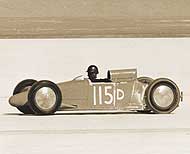
He’s about to go shiny-side down. Considering the position of the roll bar (hidden under the airscoop) in relation to Fred’s head, the cowl could have acted as a guillotine. The angels were riding with Fred one August day in 1957 at the salt flats.
|
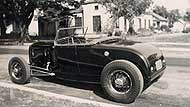
This is Fred’s ’29 roadster just before it left for Connecticut in 1948. “I probably had one of the first cross-country cruisers,” he says. “I picked it up in California and drove it to New London, Connecticut. It had a flat-knocker [flathead engine], full bellypan… the whole nine yards. Everyone thought I was crazy.”
|
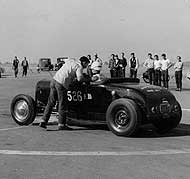
Fred talks to a friend as he warms up his much-traveled-and-raced ’29 at Santa Ana in 1951. “We westside guys ran Santa Ana in the beginning,” he says. “When they opened Saugus, which was closer, we started going there. Lou Baney [Saugus promoter] started the cash payout—only it wasn’t cash. He gave you a $25 war bond. If you knew him, he wrote you a check for $18.75.”
|

Saugus opened organized drag racing to westside rodders like Fred. Like Santa Ana, it was a landing strip. Fred (right) in his ’29 poses with track personnel. Lou Senter (in the cap) recalls, “When a plane wanted to land, they would circle overhead. We’d clear the strip and put a cross down indicating it was safe. They’d taxi and watch the races sometimes.” Lou Baney (left of Senter) also promoted the races.
|

“I bought Ak Miller’s rear-engine roadster, Miller’s Missile, and put a Chrysler in the thing,” Fred says. “It held strip records at Saugus at 140 mph and ran 197 mph at the lakes. I got it upside-down at Bonneville in 1957.”
|
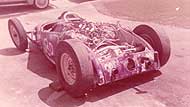
The aftermath of Fred’s horrendous crash at 200-plus: “The car was going backward, upside-down, and I slid on my hard head on the salt,” he remembers. Fred received 180 stitches on his head and face as a result. The roll bar was bent forward as the car slid backward, offering no protection. Larsen’s helmet was torn off when the mag broke and hit him on the back of his head during the slide.
|
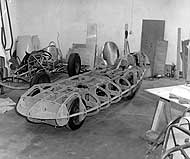
No backyard project here: Before construction began, Lynn Yakel—an aviation design engineer, fellow hot rodder, racer, and friend—fashioned a model of the streamliner. Eddie Miller of Edco Brake shaped the aluminum body. Plywood bulkheads were used to outline the skin. After two years, the body was finished the first day of Speed Week at Bonneville in 1966.
|

Here’s the Larsen & Cummins ’27 T Modified roadster. Fred and Mary Lou were at Bonneville in 1964. Fred recalls, “Mary Lou was one of the first women to go to Bonneville. Girls didn’t used to go—it was strictly a boys’ thing. Now it’s a big family affair.”
|

The late Don Cummins (left) and Fred reveal just how diminutive his beautiful 300-mph-plus streamliner is.
|
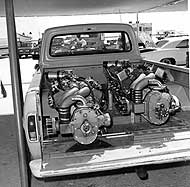
Hot rod ingenuity, 1970-style: The Chevys in Larsen’s pickup totaled 300 ci. The blown motor on the left was the smallest Chevy engine ever at 120 ci. To shrink it down, Fred removed every other piston in order to compete in the E/Streamliner class. For balance, the crank had one rod and piston and one pair of rod caps on each journal. The Larsen & Cummins team with the V-4 Chevy set a 2L Streamliner Bonneville record of 246 mph in 1970.
|
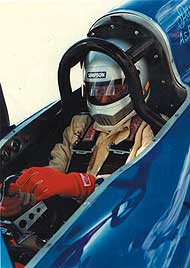
Above: Lessons learned from his crash just nine years before are evident with Larsen tucked safely in his streamliner. The full-face helmet would have saved Fred’s face and head from those 180 stitches after his wild salt slide. “The trouble with a rear-engine car [is] you have no sight pattern,” says Fred. “You’re sitting so far forward, you don’t know what’s happening back there. That’s why I built a slingshot—my streamliner. If the rear wheels move an inch, your butt moves an inch and a quarter.”
|
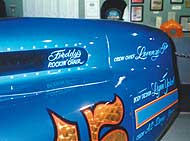
Fred says, “I was up on the line. Wes Porter, a public relations guy for the Utah press, said a lady asked him how fast I went in my car. Wes answered, ‘He went 313 mph in it, and he’s 70 years old.’ She said ‘That’s a pretty good-looking rocking chair.’ So I put it on the canopy. I retired from driving last year because I’m too damned old to work on it.” The Cummins & Larsen streamliner now resides in the NHRA Motorsports Museum in Pomona.
|
|



 Old Salt
Old Salt
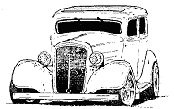


 Old Salt
Old Salt